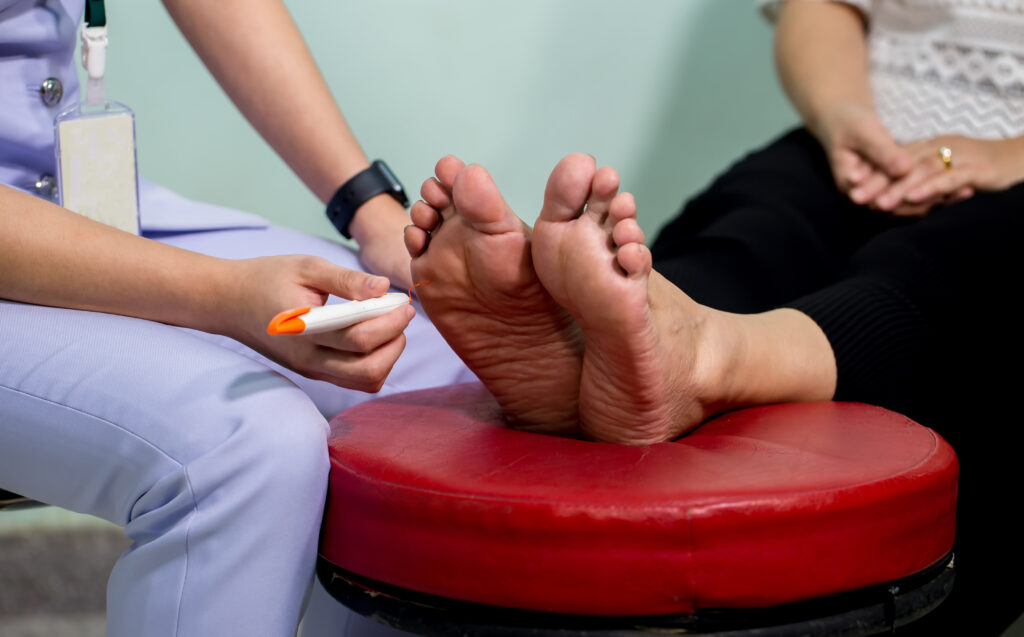New guidelines are now available for health care practitioners to provide best-practice care to people with diabetes-related foot disease — the first new guidelines in over a decade.
New Australian-based guidelines for diabetes-related foot disease have been summarised in an article published in the Medical Journal of Australia (MJA), coinciding with World Diabetes Day on 14 November 2023.
The guidelines, developed and published by Diabetes Feet Australia, are the first new Australian guidelines since 2011 and have been endorsed by ten national peak bodies.
In an exclusive podcast interview with the MJA, guideline summary authors Professor Stephen Twigg and Associate Professor Pete Lazzarini discussed the positive impact these new guidelines could have in reducing the burden of diabetes-related foot disease in Australia.
“We’ve observed over the years that well directed implemented guidelines are critical to underpinning quality care and there are a number of areas of the guidelines that have been improved and updated compared with the ones from 2011,” Professor Twigg said.
Professor Stephen Twigg is a Clinical Academic and the Kellion Professor of Endocrinology and Stan Clark Chair in Diabetes at the University of Sydney.
“Practically developed clinical care guidelines that are up to date can really make a positive difference to health care outcomes and, in this case, for people with foot disease,” he said.
The theme of this year’s World Diabetes Day is “Know your risk, know your response”, encouraging people to know their risk level and what to do to support prevention, early diagnosis and timely treatment.

A significant disease burden
Diabetes-related foot disease is a leading cause of hospitalisation, amputation, disability and health care costs in Australia.
It is estimated that 300 000 Australians are at risk of developing diabetes-related foot disease annually.
“Most of those have diabetes-related peripheral neuropathy or peripheral arterial disease, which puts them at risk of developing the more severe diabetic foot ulcers and infections,” Associate Professor Pete Lazzarini said.
Associate Professor Pete Lazzarini is a conjoint Principal Research Fellow at Metro North Hospital and Health Service and Queensland University of Technology in Brisbane.
“Each year, around 50 000 Australians are walking around with an ulcer and around half of those are infected at any one time.
“That results in around 30 000 hospitalisations caused by diabetic foot disease each year … then 5000 unfortunately have some form of amputation because of diabetic foot disease.”
The guidelines at a glance
The 98 recommendations made across six new guidelines for the general medical audience have been summarised in the MJA:
- prevention — screening, education, self-care, footwear, and treatments to prevent diabetic foot disease;
- classification — classifications systems for ulcers, infection, ischaemia and auditing;
- peripheral artery disease — examinations and imaging for diagnosis, severity classification, and treatments;
- infection — examinations, cultures, imaging and inflammatory markers for diagnosis, severity classification, and treatments;
- offloading — pressure offloading treatments for different ulcer types and locations; and
- wound healing — debridement, wound dressing selection
The changes include a new risk stratification system for screening of people without diabetes-related foot disease, with more specific self-monitoring, footwear prescription, surgical treatments and activity management practices for those at increased risk.
For people with diabetes-related foot disease, there are new ulcer, infection and peripheral artery disease classification systems, with more specific recommendations to resolve diabetes-related foot disease.
Diabetes Feet Australia has created an interactive platform for the guidelines, which health care practitioners can use with their patients.
“GPs or podiatrists or nurses with a patient with diabetes-related foot disease in front of them can click on these pathways to identify the recommendations that apply for that particular patient in terms of assessment, education and management,” Associate Professor Lazzarini said.
Guidelines give new hope
The authors hope the new guidelines will assist health care practitioners to deliver best practice care to their patients, and ultimately reduce the burden of diabetes-related foot disease in Australia.
“We’ve got evidence now from the research that … we can reduce these burdens just by implementing guideline-based care,” Associate Professor Lazzarini said.
Professor Twigg agreed.
“The field is moving forward really well in terms of foot care with diabetes,” Professor Twigg said.
“There’s good evidence that we can improve outcomes and with further research we’ll be able to find better methods again.
“So I remain optimistic but recognise there’s a lot of work to do still to try and help ensure that these clinical care guidelines and health pathways can optimise outcomes for people across Australia.”
Read the guideline summary in the Medical Journal of Australia.
Listen to the MJA Podcast
Subscribe to the free InSight+ weekly newsletter here. It is available to all readers, not just registered medical practitioners.

 more_vert
more_vert
Arterial disease is grossly underestimated in patients with foot ulcers – whether diabetic or not – but worse in diabetics and the disease is often very distal and therefore more difficult to treat. Early treatment is essential or else the cycle of “nibbling” toes off begins. Angiography is required for every diabetic foot ulcer as tibial artery disease cannot be properly assessed in any other way.
Peripheral neuropathy is also not confined to diabetics and often leads to amputations because of unrecognised damage to tissue and then non compliance with off loading because of lack of pain. Pain is protective.
Any foot ulcer is of concern and needs to be assessed for arterial insufficiency, neuropathy and off loading.
Off loading is done very badly on the whole and needs to be completely restructured.
I can understand this seems a good idea but to me it can lead to peole on the hogher end of noemal blood glucose and who have a lesion(s) on th foot area from some benign origin being labelled diabetecwhen they are not.